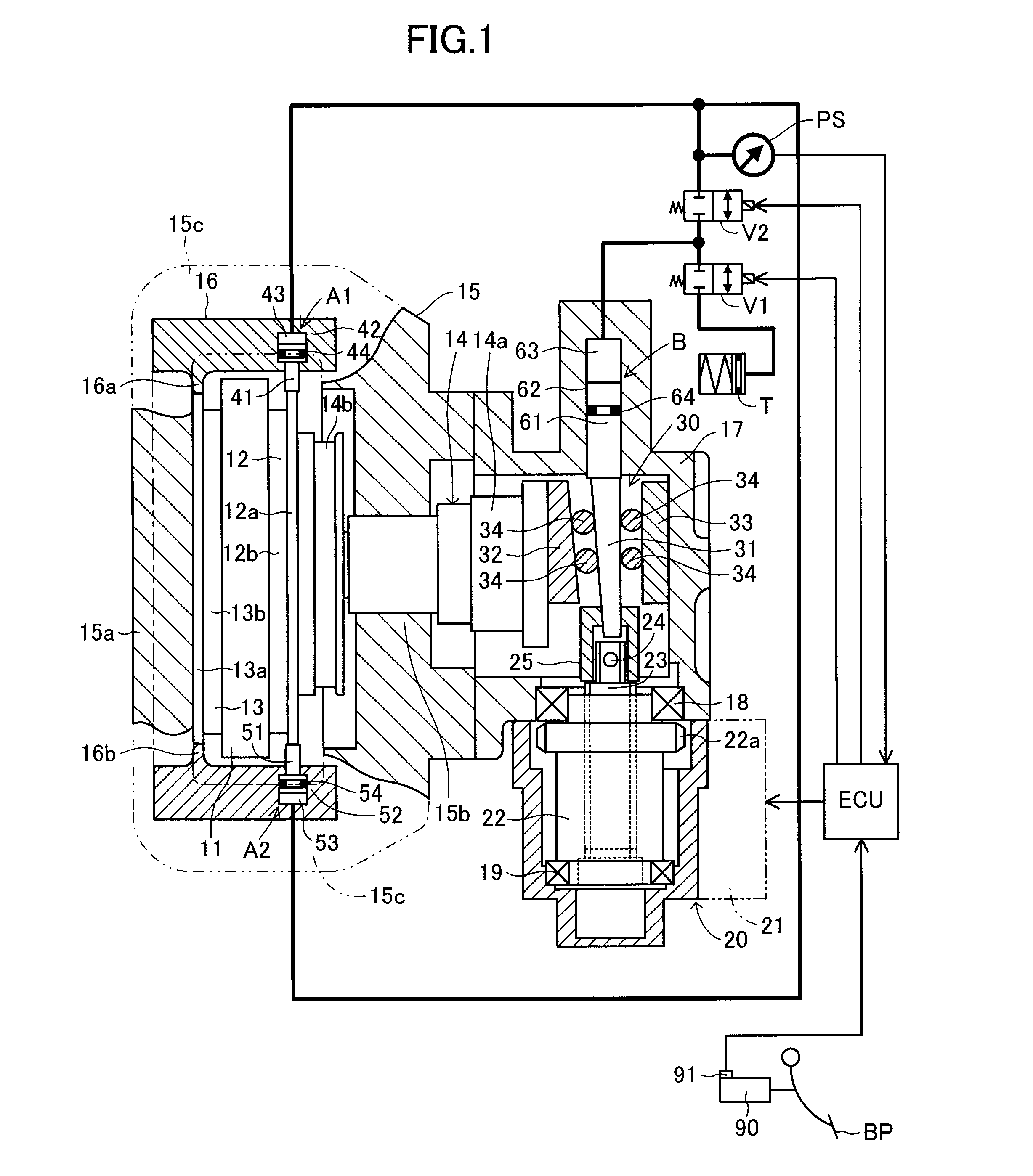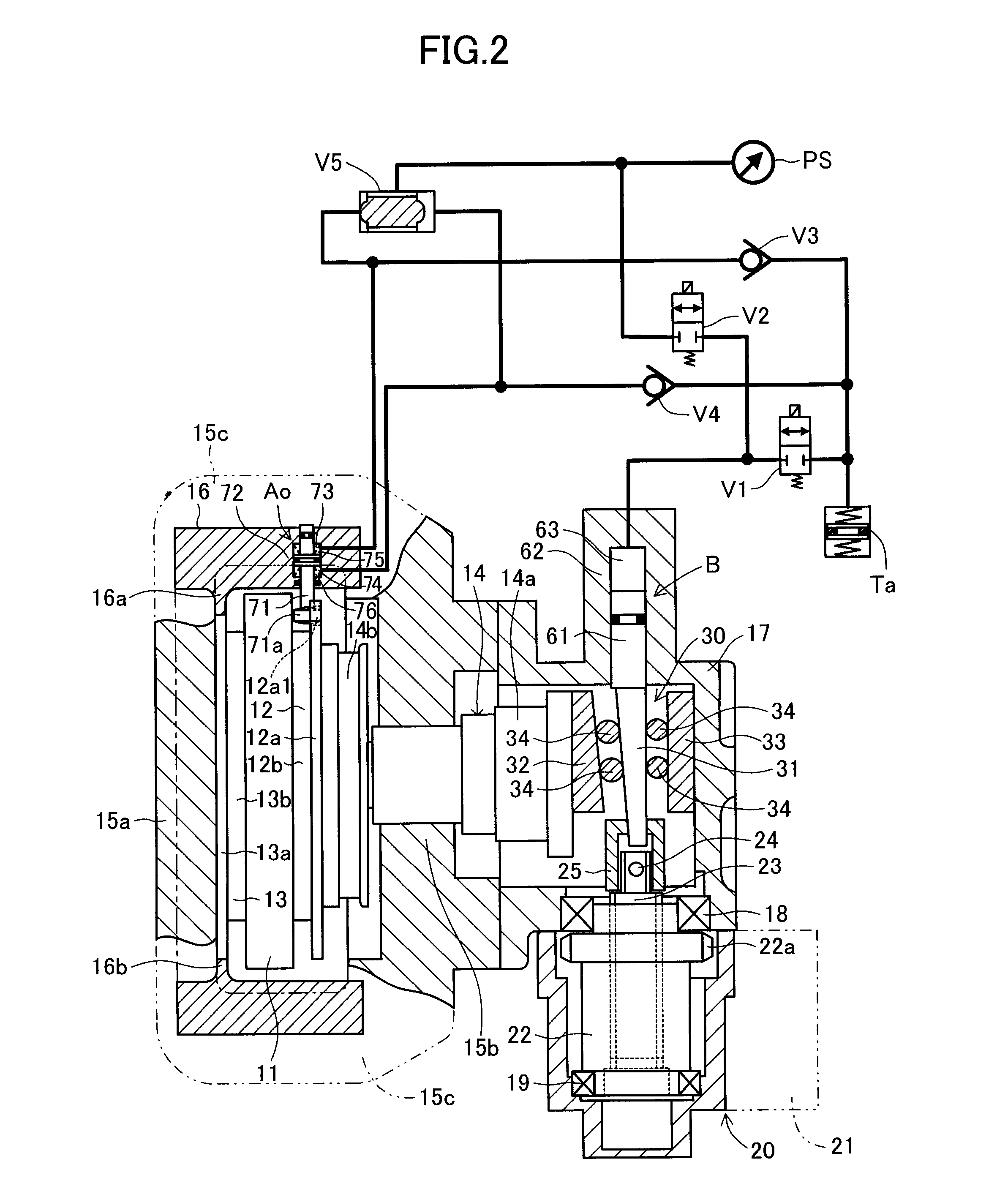Disc Brake Apparatus
a disc brake and disc rotor technology, applied in the direction of axially engaging brakes, brake types, actuators, etc., can solve the problem that the disc brake apparatus cannot brake the disc rotor, and achieve the effect of preventing an excessive increase in the servo load
- Summary
- Abstract
- Description
- Claims
- Application Information
AI Technical Summary
Benefits of technology
Problems solved by technology
Method used
Image
Examples
first embodiment
[0041] In the thus-configured disc brake apparatus of the first embodiment, when the brake pedal BP is stepped on, the electric motor 21 is rotationally driven in the regular direction (braking direction). A rotational drive force of the electric motor 21 is converted to an axial drive force (a drive force directed downward in FIG. 1) of the screw shaft 23 via the nut 22. The wedge transmission mechanism 30 converts the axial drive force of the screw shaft 23 to an axial drive force (a drive force directed leftward in FIG. 1) of the braking piston 14 and transmits the axial drive force to the braking piston 14.
[0042] By the above process, the braking piston 14 is axially driven and pushes the inner pad 12 toward the disc rotor 11 and presses it against the disc rotor 11, and an associated reaction force causes the reaction-force arm portion 15a of the caliper 15 to push the outer pad 13 toward the disc rotor 11 and press it against the disc rotor 11, whereby the inner pad 12 and the...
second embodiment
[0060] The second embodiment employs the changeover valve V5 which functions as follows: in the case where a positive pressure is built up in the oil chamber 75, while a negative pressure is built up in the oil chamber 76, the changeover valve V5 establishes communication between the oil chamber 75 and the pressure-increasing solenoid valve V2 and shuts off communication between the oil chamber 76 and the pressure-increasing solenoid valve V2; and in the case where a negative pressure is built up in the oil chamber 75, while a positive pressure is built up in the oil chamber 76, the changeover valve V5 shuts off communication between the oil chamber 75 and the pressure-increasing solenoid valve V2 and establishes communication between the oil chamber 76 and the pressure-increasing solenoid valve V2. However, as shown in FIG. 4, in place of the changeover valve V5, a pair of check valves V5a and V5b may be employed.
third embodiment
[0061] The above-described embodiments employ the motor-driven actuator 20 as an actuator which operates in accordance with the operation force. However, as shown in FIG. 5, which shows the present invention, the present invention can be embodied by employing a hydraulic actuator 120 as an actuator which operates in accordance with the operation force, and a stepped braking piston 114 which is pushed by means of the hydraulic actuator 120 and a servo cylinder 162, which serves as a servomechanism.
[0062] The hydraulic actuator 120 of the third embodiment shown in FIG. 5 is a brake master cylinder which operates in response to the driver stepping on the brake pedal BP. An oil pressure which is built up in the hydraulic actuator 120 (an oil pressure which depends on the operation force) can be detected by a sensor 121 and can be supplied to an oil chamber R1 where a small-diameter portion 114a of the braking piston 114 is exposed. The servo cylinder 162 is provided integrally with the ...
PUM
 Login to View More
Login to View More Abstract
Description
Claims
Application Information
 Login to View More
Login to View More - R&D
- Intellectual Property
- Life Sciences
- Materials
- Tech Scout
- Unparalleled Data Quality
- Higher Quality Content
- 60% Fewer Hallucinations
Browse by: Latest US Patents, China's latest patents, Technical Efficacy Thesaurus, Application Domain, Technology Topic, Popular Technical Reports.
© 2025 PatSnap. All rights reserved.Legal|Privacy policy|Modern Slavery Act Transparency Statement|Sitemap|About US| Contact US: help@patsnap.com



